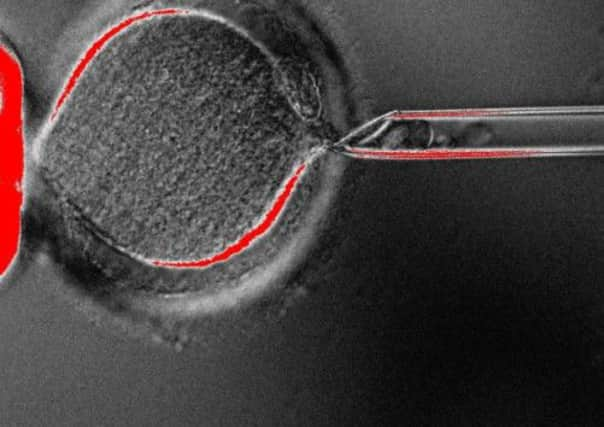Cloning scientists create stem cells from skin


The advance, described as a “milestone”, is expected to aid the development of stem cell therapies that avoid fertilised human embryos.
But since it employs a cloning technique it is certain to fuel controversy over “Brave New World” science.
Advertisement
Hide AdAdvertisement
Hide AdThe US scientists said they were not interested in cloning humans and did not believe their methods could successfully be used in this way.
But the therapeutic cloning technique they employed would also be the start of the process of making duplicate humans.
It is the first time scientists have managed to create human embryos through cloning developed enough to provide stem cells.
The same somatic cell nuclear transfer (SCNT) technique was employed by researchers at the Roslin Institute in Edinburgh to produce Dolly the Sheep, the first mammal to be cloned from an adult cell.
Grown
During SCNT, a donor cell nucleus is transferred to an egg cell whose own nuclear DNA has been removed. The egg develops into an early-stage embryo that is a clone of the donor, containing the same genes.
Stem cells taken from the embryo are “pluripotent”, having the ability - with the right coaxing - to mature into any kind of tissue in the body, from brain to bone.
In the new study, reported in the journal Cell, scientists transferred nuclei from human skin cells into human egg cells.
They generated “blastocysts”, early embryos consisting of a cluster of 150 cells, from which human embryonic stem cells (hESCs) were obtained and grown in the laboratory.
Advertisement
Hide AdAdvertisement
Hide AdScientists have previously cloned monkey embryos and mined them for stem cells, but until now been frustrated in their attempts to do the same with humans.
Generally it has not proved possible to create human embryos that develop further than the eight cell stage - too early to yield stem cells.
A key problem has been that human egg cells appear more fragile than those of other species.
Damaged organs
Lead researcher Professor Shoukhrat Mitalipov, from Oregon Health and Science University, said: “Our finding offers new ways of generating stem cells for patients with dysfunctional or damaged tissues and organs,.
“Such stem cells can regenerate and replace those damaged cells and tissues and alleviate diseases that affect millions of people.”
The stem cells demonstrated an ability to convert into several different cell types, including nerve, liver and heart cells.
Prof Mitalipov added: “Furthermore, because these reprogrammed cells can be generated with nuclear genetic material from a patient, there is no concern of transplant rejection.
“While there is much work to be done in developing safe and effective stem cell treatments, we believe this is a significant step forward in developing the cells that could be used in regenerative medicine.”
Advertisement
Hide AdAdvertisement
Hide AdHuman embryonic stem cells are normally derived from “unwanted” fertilised human embryos left over from IVF treatment, which raises ethical concerns.
Recently, another advance has led to induced pluripotent stem cells (iPSCs) which have most of the same properties as embryonic stem cells.
These are adult cells which have been genetically reprogrammed to revert to an embryonic-like state.
Fragile
But there are fears about the safety of treatments based on this technique because of the possibility of unexpected mutations.
Prof Mitalipov spelled out the distinction between therapeutic cloning, the technique used in his research, and reproductive cloning.
He doubted that the same method could be used to clone human babies.
Scientists had never cloned a monkey using SCNT despite several years of trying, he pointed out.
Cloning humans would be even more difficult, especially given the fragility of human eggs.
Advertisement
Hide AdAdvertisement
Hide AdProf Mitalipov added: “Our research is directed toward generating stem cells for use in future treatments to combat disease.
“While nuclear transfer breakthroughs often lead to a public discussion about the ethics of human cloning, this is not our focus, nor do we believe our findings might be used by others to advance the possibility of human reproductive cloning.”